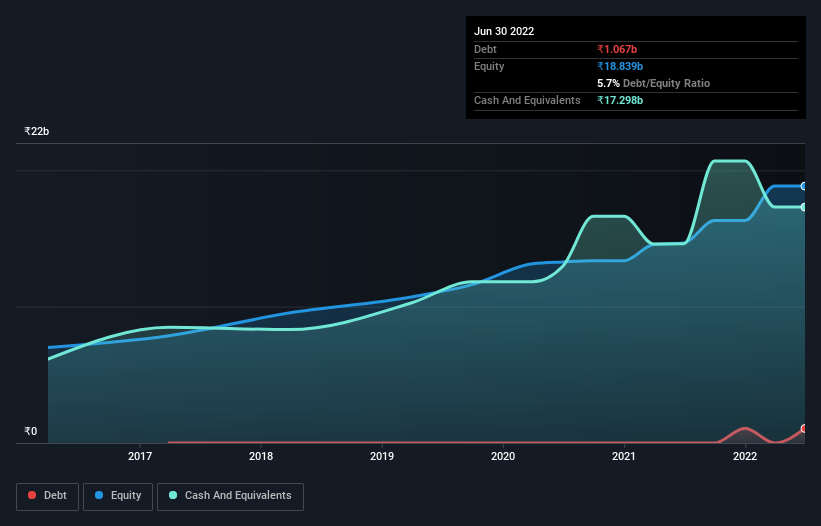- India
- /
- Commercial Services
- /
- NSEI:IRCTC
Indian Railway Catering & Tourism (NSE:IRCTC) Seems To Use Debt Rather Sparingly

Some say volatility, rather than debt, is the best way to think about risk as an investor, but Warren Buffett famously said that 'Volatility is far from synonymous with risk.' So it seems the smart money knows that debt - which is usually involved in bankruptcies - is a very important factor, when you assess how risky a company is. Importantly, Indian Railway Catering & Tourism Corporation Limited (NSE:IRCTC) does carry debt. But the real question is whether this debt is making the company risky.
When Is Debt Dangerous?
Generally speaking, debt only becomes a real problem when a company can't easily pay it off, either by raising capital or with its own cash flow. In the worst case scenario, a company can go bankrupt if it cannot pay its creditors. However, a more usual (but still expensive) situation is where a company must dilute shareholders at a cheap share price simply to get debt under control. Of course, the upside of debt is that it often represents cheap capital, especially when it replaces dilution in a company with the ability to reinvest at high rates of return. The first thing to do when considering how much debt a business uses is to look at its cash and debt together.
Check out our latest analysis for Indian Railway Catering & Tourism
What Is Indian Railway Catering & Tourism's Debt?
You can click the graphic below for the historical numbers, but it shows that as of March 2022 Indian Railway Catering & Tourism had ₹1.07b of debt, an increase on none, over one year. However, it does have ₹17.3b in cash offsetting this, leading to net cash of ₹16.2b.

How Strong Is Indian Railway Catering & Tourism's Balance Sheet?
The latest balance sheet data shows that Indian Railway Catering & Tourism had liabilities of ₹17.8b due within a year, and liabilities of ₹1.69b falling due after that. Offsetting this, it had ₹17.3b in cash and ₹7.06b in receivables that were due within 12 months. So it can boast ₹4.82b more liquid assets than total liabilities.
This state of affairs indicates that Indian Railway Catering & Tourism's balance sheet looks quite solid, as its total liabilities are just about equal to its liquid assets. So it's very unlikely that the ₹531.6b company is short on cash, but still worth keeping an eye on the balance sheet. Succinctly put, Indian Railway Catering & Tourism boasts net cash, so it's fair to say it does not have a heavy debt load!
Even more impressive was the fact that Indian Railway Catering & Tourism grew its EBIT by 248% over twelve months. That boost will make it even easier to pay down debt going forward. When analysing debt levels, the balance sheet is the obvious place to start. But it is future earnings, more than anything, that will determine Indian Railway Catering & Tourism's ability to maintain a healthy balance sheet going forward. So if you want to see what the professionals think, you might find this free report on analyst profit forecasts to be interesting.
Finally, a business needs free cash flow to pay off debt; accounting profits just don't cut it. Indian Railway Catering & Tourism may have net cash on the balance sheet, but it is still interesting to look at how well the business converts its earnings before interest and tax (EBIT) to free cash flow, because that will influence both its need for, and its capacity to manage debt. During the last three years, Indian Railway Catering & Tourism produced sturdy free cash flow equating to 67% of its EBIT, about what we'd expect. This free cash flow puts the company in a good position to pay down debt, when appropriate.
Summing Up
While it is always sensible to investigate a company's debt, in this case Indian Railway Catering & Tourism has ₹16.2b in net cash and a decent-looking balance sheet. And we liked the look of last year's 248% year-on-year EBIT growth. So we don't think Indian Railway Catering & Tourism's use of debt is risky. The balance sheet is clearly the area to focus on when you are analysing debt. However, not all investment risk resides within the balance sheet - far from it. We've identified 1 warning sign with Indian Railway Catering & Tourism , and understanding them should be part of your investment process.
When all is said and done, sometimes its easier to focus on companies that don't even need debt. Readers can access a list of growth stocks with zero net debt 100% free, right now.
New: AI Stock Screener & Alerts
Our new AI Stock Screener scans the market every day to uncover opportunities.
• Dividend Powerhouses (3%+ Yield)
• Undervalued Small Caps with Insider Buying
• High growth Tech and AI Companies
Or build your own from over 50 metrics.
Have feedback on this article? Concerned about the content? Get in touch with us directly. Alternatively, email editorial-team (at) simplywallst.com.
This article by Simply Wall St is general in nature. We provide commentary based on historical data and analyst forecasts only using an unbiased methodology and our articles are not intended to be financial advice. It does not constitute a recommendation to buy or sell any stock, and does not take account of your objectives, or your financial situation. We aim to bring you long-term focused analysis driven by fundamental data. Note that our analysis may not factor in the latest price-sensitive company announcements or qualitative material. Simply Wall St has no position in any stocks mentioned.
About NSEI:IRCTC
Indian Railway Catering & Tourism
Engages in the provision of catering and hospitality, Internet ticketing, travel and tourism, and packaged drinking water services in India.
Flawless balance sheet with acceptable track record.
Similar Companies
Market Insights
Community Narratives


